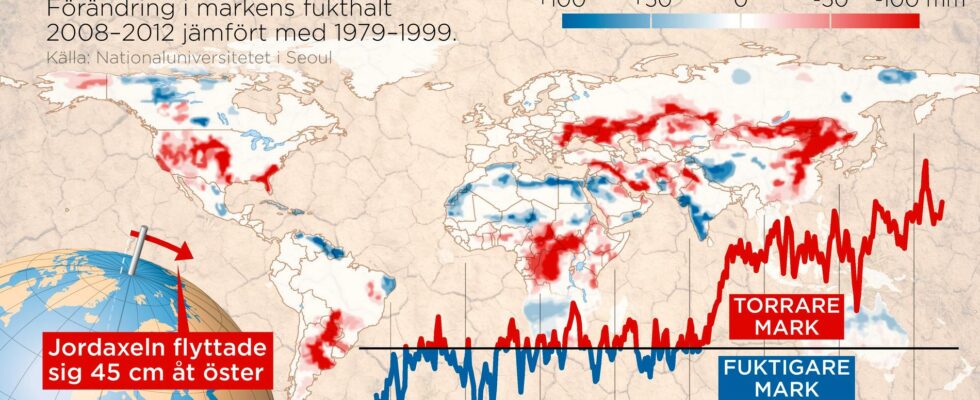UNSaveSpara
Expand-Left
The full -screen evaporation from land affects sea levels and also the earth’s rotational axis. Photo: Anders Humlebo/TT
Moisture disappears from huge land areas on the earth. This has led to both sea level increases and that the entire planet’s slope has shifted, according to new research.
“These are huge numbers that no one has known about,” says researcher Seo Ki-Weon.
The amount of moisture in the soil can have major consequences that affect the entire planet. This is the conclusion of a study that an international research team has come up with.
Between 2000 and 2002, large lands dried out.
– There are two reasons. One is that there was less rainfall over land areas, the other important is that we have a larger Evapotranspiration, says Seo Ki-Weon, the main author of the study and professor of geoscience at National University in Seoul, and continues:
– This means that we lose moisture from land to the atmosphere, probably as a result of increased temperatures.
“Surprisingly”
During the three years, 1,614 gigatone disappeared moisture from the ground, where a gigaton corresponds to about a cubic kilometer water. A large part of this eventually ended up in the seas, which was raised 4.5 millimeters.
– It’s a surprising speech. Because when compared to the melting in Greenland – the largest contribution to the sea increase – it contributes 0.7–0.8 millimeters per year.
This connection has not been known before, even though the change is so great that the whole earth has been distorted.
– The earth’s rotational axis is not fixed. This is because the mass of the earth changes, depending on high and low pressure, winds, streams and ice that melt. Some water is moved to new places and this causes the earth’s rotational axis to change.
The fact that a lot of moisture disappeared from the land surfaces helped the soil axis moved 45 centimeters until 2012. That the soil is turned can sound scary.
– It is not a big movement, so it probably has no great significance. I think we’re safe, says Seo Ki-Weon with a laugh.
Here to stay
What is, on the other hand, worrying is how evaporation from land can affect sea levels. The loss between 2000–2002 was extreme, but between 2003 and 2016 the land surfaces dropped another 1,009 gigaton, thus added 2.76 millimeters of sea level rise. The levels may never return to the normal.
– Probably this is due to climate change, so we must be vigilant when it comes to drought in the future. That is the message to ordinary people, says Seo Ki-Weon.
Gabriele Messori, professor of meteorology at Uppsala University, thinks that the study is interesting and that strengthens research on trends against increasing drought, which, among other things, the UN Climate Panel previously reported on in certain regions.
– This study draws much clearer conclusions, he says.
The factual plan is changing
The researchers have investigated the changes in moisture in the soil between 1979 and 2016, and compared to sea levels and the earth’s rotation shaft.
Especially over Euroasia and North America is affected by reduced humidity in the soil. Between 2000 and 2002, a drastic reduction took place, which led to both the sea level being raised and the relocation of the earth’s rotation axis.
The study is published in the journal Science.
Read more
